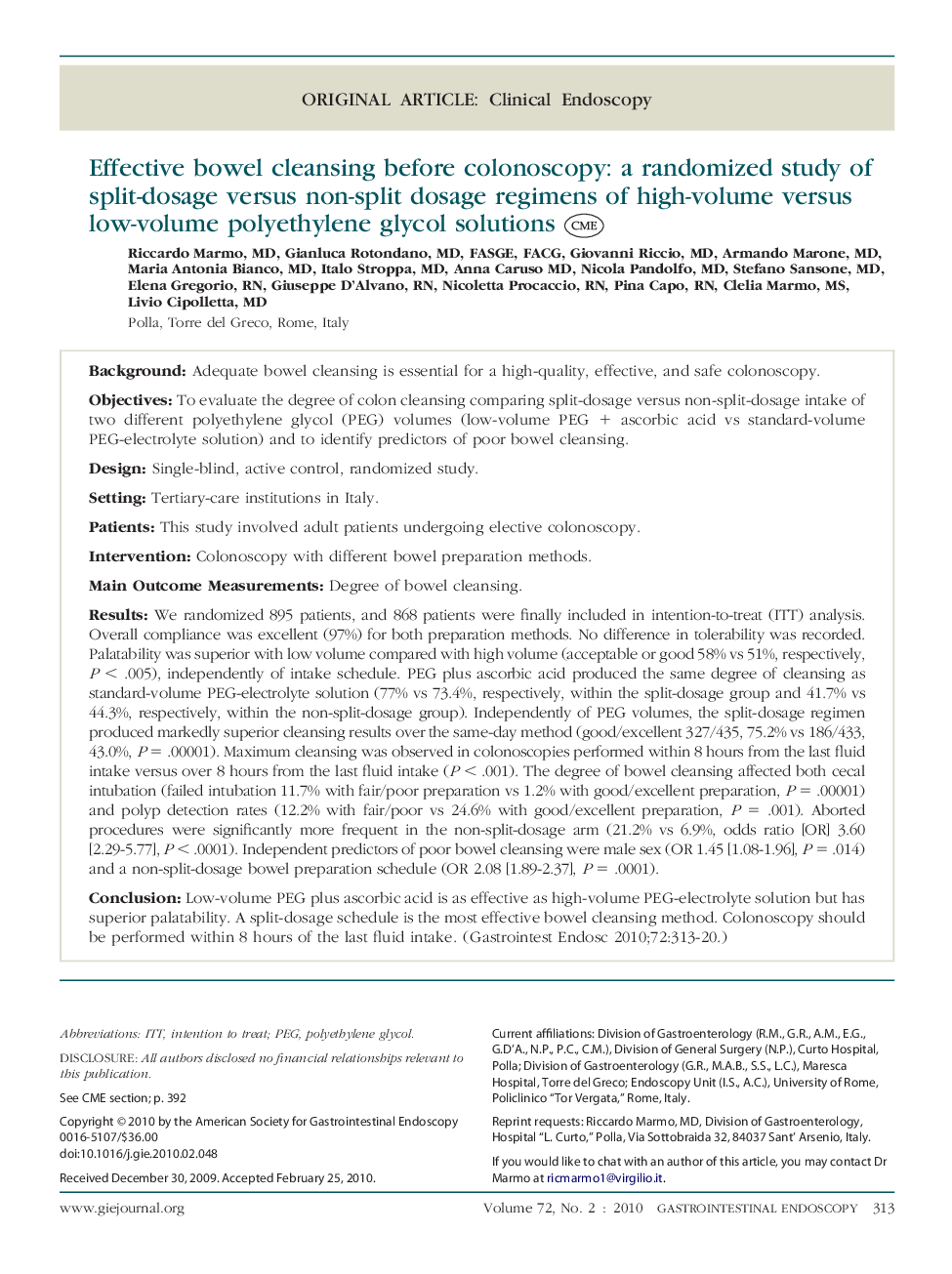| کد مقاله | کد نشریه | سال انتشار | مقاله انگلیسی | نسخه تمام متن |
|---|---|---|---|---|
| 6098622 | 1210377 | 2010 | 8 صفحه PDF | دانلود رایگان |

BackgroundAdequate bowel cleansing is essential for a high-quality, effective, and safe colonoscopy.ObjectivesTo evaluate the degree of colon cleansing comparing split-dosage versus non-split-dosage intake of two different polyethylene glycol (PEG) volumes (low-volume PEG + ascorbic acid vs standard-volume PEG-electrolyte solution) and to identify predictors of poor bowel cleansing.DesignSingle-blind, active control, randomized study.SettingTertiary-care institutions in Italy.PatientsThis study involved adult patients undergoing elective colonoscopy.InterventionColonoscopy with different bowel preparation methods.Main Outcome MeasurementsDegree of bowel cleansing.ResultsWe randomized 895 patients, and 868 patients were finally included in intention-to-treat (ITT) analysis. Overall compliance was excellent (97%) for both preparation methods. No difference in tolerability was recorded. Palatability was superior with low volume compared with high volume (acceptable or good 58% vs 51%, respectively, P < .005), independently of intake schedule. PEG plus ascorbic acid produced the same degree of cleansing as standard-volume PEG-electrolyte solution (77% vs 73.4%, respectively, within the split-dosage group and 41.7% vs 44.3%, respectively, within the non-split-dosage group). Independently of PEG volumes, the split-dosage regimen produced markedly superior cleansing results over the same-day method (good/excellent 327/435, 75.2% vs 186/433, 43.0%, P = .00001). Maximum cleansing was observed in colonoscopies performed within 8 hours from the last fluid intake versus over 8 hours from the last fluid intake (P < .001). The degree of bowel cleansing affected both cecal intubation (failed intubation 11.7% with fair/poor preparation vs 1.2% with good/excellent preparation, P = .00001) and polyp detection rates (12.2% with fair/poor vs 24.6% with good/excellent preparation, P = .001). Aborted procedures were significantly more frequent in the non-split-dosage arm (21.2% vs 6.9%, odds ratio [OR] 3.60 [2.29-5.77], P < .0001). Independent predictors of poor bowel cleansing were male sex (OR 1.45 [1.08-1.96], P = .014) and a non-split-dosage bowel preparation schedule (OR 2.08 [1.89-2.37], P = .0001).ConclusionLow-volume PEG plus ascorbic acid is as effective as high-volume PEG-electrolyte solution but has superior palatability. A split-dosage schedule is the most effective bowel cleansing method. Colonoscopy should be performed within 8 hours of the last fluid intake.
Journal: Gastrointestinal Endoscopy - Volume 72, Issue 2, August 2010, Pages 313-320